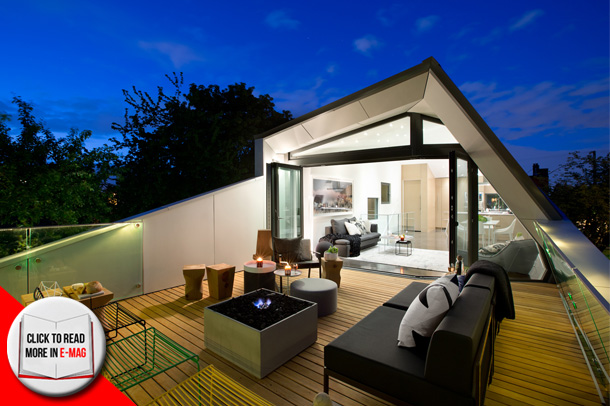By Cheryl Long
Every business faces unique challenges during the start-up phase, but launching a new venture during a recession is a level of daring few would attempt. It was that kind of fearlessness and entrepreneurial spirit that marked the beginning of the Cascadia Windows success story.
Mike Battistel is Vice President, Operations for Cascadia Windows in Langley, British Columbia. His career began in the construction industry in the late 1980s as a tradesman working on building envelope systems and assemblies, earning his qualifications as a journeyman in glazing and carpentry. After deciding to pursue a career as a building envelope consultant, Battistel enrolled at the British Columbia Institute of Technology (BCIT) to study building science and then joined RDH Building Engineering after graduation. RDH was a new company at that time but it was gaining recognition thanks to the company’s founders who were considered some of the top building envelope consultants in the industry.
After a year with RDH, Battistel became a shareholder and later relocated to Seattle, Washington to open the company’s new office in the U.S. and introduce rainscreen construction to the area’s architects. Rainscreen construction is a design approach used to control rain penetration into the exterior envelope, or the walls and roof, of a building. RDH was involved in writing many of the industry standards and guidelines that led to rainscreen design becoming a building code requirement, Battistel said, partly in response to the leaky condo crisis of the 1990s that caused billions of dollars in damage to buildings and housing units, particularly in B.C.
Turning the focus to energy conservation
After two years in Seattle, Battistel returned to become one of the principals at RDH. By 2007, the leaky condo crisis had tapered off and some of the partners at RDH began talking about new business opportunities. With water penetration resistance well under control, the partners turned their attention to energy conservation.
“We thought about how we could best help the industry improve energy conservation in buildings and recognized that windows are typically the weakest link thermally in the building envelope,” Battistel said. Most of the windows being used in large commercial buildings at that time had aluminum frames with low R-values; vinyl wasn’t an option because it wasn’t stable enough to hold large spans of glass. The solution? Fiberglass.
That’s when an owner group from RDH partnered up with John Sawatzky, a fiberglass windows specialist, and decided to launch Cascadia Windows, smack in the middle of the 2008 recession. During the first year, the owners hired employees to run the fledgling company but soon realized that manufacturing fiberglass-framed windows was more complicated than anyone expected. They needed to dedicate one of the owners from the RDH group to run the company, and in 2009 Battistel stepped into the Cascadia role full time.
“The first few years were very difficult because we started right when there was a recession starting and there was no market for fiberglass windows,” Battistel said. “Not many people knew much about them … we were basically trying to make everybody aware this was a viable solution for reducing energy consumption in buildings.”
It was a challenging time for the industry. Contractors were choosing less expensive products for their projects and, in some cases, developments weren’t going ahead at all. Cascadia Windows had to make a name for themselves and the best way to do that was take the work that no one else could or wanted to do. “We started becoming very good at building very large custom configurations that the vinyl guys couldn’t do, and that the aluminum guys couldn’t do because of the poor energy ratings they were getting.”
Steady growth year after year
By 2011, the economy was rebounding and Cascadia Windows was developing a solid reputation for both their products and service. Despite the economic climate, the company had been growing at a rate of about 20 percent annually and had also restructured to bring on a partner with significant depth and complementary resources. Today, the business that began with less than 15 people now employs closer to 50 and revenue has increased five-fold.
Most of the work Cascadia does is concentrated in the commercial and institutional sectors, including schools and hospitals, but they’ve also been contracted to supply windows and doors in high-end custom homes. The company’s photo gallery at www.cascadiawindows.com offers a stunning look at their range of work, from multi-million-dollar homes with spectacular views to multi-storey commercial buildings, innovative institutional designs and renovation work, like the Mark O. Hatfield Preservation Project in Portland, Oregon.
They also supplied windows for the first net zero home built on North America’s West coast. The Harmony House in Burnaby, British Columbia produces as much energy as it consumes through the use of renewable energy technologies and energy conservation strategies like its triple-glazed Cascadia Windows.
“Not only are our windows exceptional from a thermal resistance standpoint, they’re also exceptional from a water penetration resistance standpoint,” Battistel said. “We have an in-house testing facility, testing about 10 percent of our production volume… to make sure they’re meeting water penetration resistance ratings that are the highest recognized ratings in the entire industry.”
Cascadia has supplied products for projects receiving numerous awards, including two winners of the Canada Green Building Awards in 2013 and 2014, the 2013 Project Excellence Award from Fenestration West Magazine and a 2013 Beyond Green Award from the National Institute of Building Sciences in Washington, D.C., among others.
Cascadia Clip in demand nation-wide
One of the company’s greatest achievements has been the invention of the Cascadia Clip, a thermal spacer that doubles the effective R-value of a conventional exterior insulated wall, Battistel explained. The product is in demand across North America, and is a very big seller for Cascadia.
The innovative window company has made huge strides in six years. They’re recognized as a high quality company with excellent products and the market for fiberglass windows continues to grow. Their greatest challenge now lies in the search for skilled labour, which can be difficult given the company’s consistent growth rate.
“There’s no other fiberglass window manufacturing company on the West Coast so when we hire people to produce the products or work in our shop, they don’t have any previous fiberglass window manufacturing experience. We have to train them from scratch so that’s difficult,” Battistel explained. “There’s that learning curve in the beginning.”
But that continuous effort to expand the Cascadia Windows team has its silver lining. It means the high rate of growth they’ve been experiencing year after year is showing no signs of slowing down.
“We are planning on continuing to grow and we’re going to be growing not only in this market, but we’re going to be expanding into other markets,” Battistel said. “One of the key things for us is we’re going to continue to innovate new products and new solutions to help buildings become more energy efficient and help with energy conservation.”







